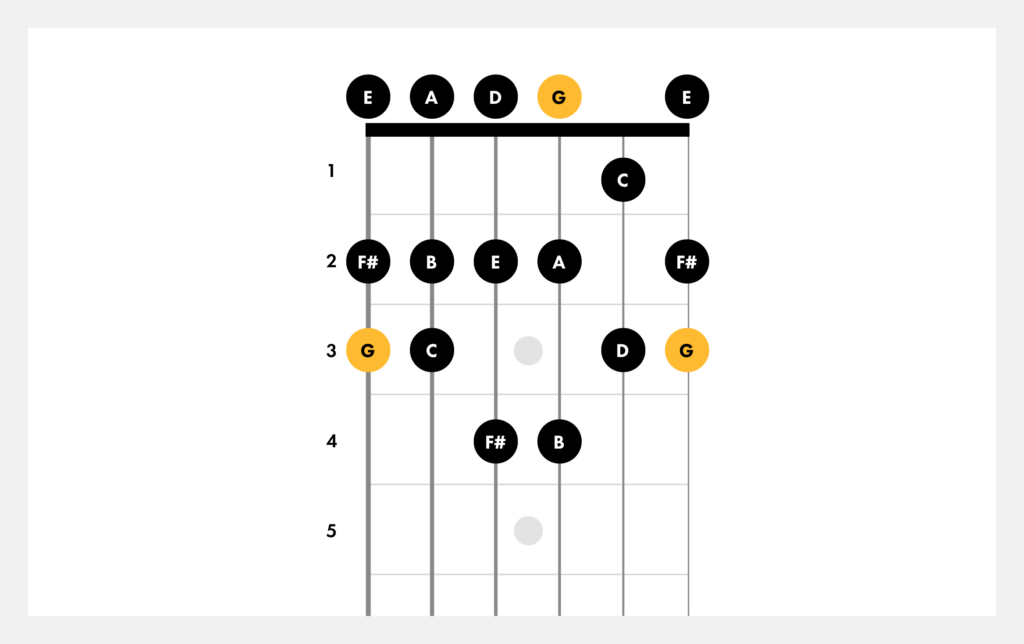Learning to play the G major scale across the guitar fretboard is a fundamental skill for any guitarist. It not only helps in understanding the layout of the fretboard but also improves finger strength, dexterity, and musicality. Here’s a comprehensive guide to mastering the G major scale on the guitar.
Understanding the G Major Scale
The G major scale consists of the following notes: G, A, B, C, D, E, F#, and G (octave). The formula for the major scale is whole, whole, half, whole, whole, whole, half steps (W-W-H-W-W-W-H).
Basic G Major Scale Position (Open Position)
Let’s start with the most basic position, the open position:
Open Position

This pattern is ideal for beginners as it stays close to the nut and incorporates open strings, making it easier to play.
e|————————-2–3—–|
B|——————-0–1–3——–|
G|—————0–2—————|
D|———0–2———————|
A|—0–2—————————|
E|—3——————————|
Moving Up the Fretboard
Once you’re comfortable with the open position, it’s time to move up the neck. Here are five positions of the G major scale across the fretboard:
Position 1: 3rd to 5th Fret

e|——————-2–3–5–|
B|—————3–5———|
G|——-2–4–5————–|
D|—2–4———————|
A|–5————————-|
E|—————————-|
Position 2: 5th to 8th Fret

e|————————5–7–8–|
B|——————-5–7———-|
G|————4–5-7—————|
D|——–5-7———————-|
A|—5-7—————————|
E|–7——————————|
Position 3: 7th to 10th Fret

e|———————–7–8–10–|
B|—————-7–8————-|
G|———-7–9——————-|
D|—–7–9————————|
A|–10—————————–|
E|———————————|
Position 4: 10th to 12th Fret

e|————————10–12–|
B|——————10–12——–|
G|————9–11—————|
D|——9–12———————|
A|–10—————————-|
E|——————————–|
Position 5: 12th to 15th Fret
e|————————-12–14–15–|
B|——————-12–13————|
G|————–12–14—————–|
D|———12-14———————–|
A|–12–14—————————–|
E|————————————-|
Connecting the Positions
To truly master the G major scale, practice transitioning between these positions smoothly. This will help you navigate the fretboard effortlessly and play in different areas of the neck
Example Exercise:
- Start in the open position and play the scale ascending and descending.
- Move to the 3rd to 5th fret position and repeat the process.
- Continue through all positions up to the 12th fret.
By practicing these connections, you will develop a deeper understanding of the fretboard and gain the ability to improvise solos and compose melodies with ease.
Practice Tips
- Use a Metronome: Start slow and gradually increase the speed. This helps in building timing and accuracy.
- Alternate Picking: Ensure you use alternate picking (down-up strokes) to maintain a steady rhythm.
- Focus on Clarity: Each note should ring out clearly without any buzzing or muted sounds.
- Explore Different Rhythms: Try playing the scale in various rhythmic patterns to make your practice sessions more interesting.
Conclusion
Mastering the G major scale across the guitar fretboard is an essential skill for any guitarist. It provides a strong foundation for further exploration into scales, chords, and improvisation. By practicing diligently and exploring different positions, you’ll gain confidence and flexibility in your playing, opening up new possibilities for musical expression. Happy playing!

